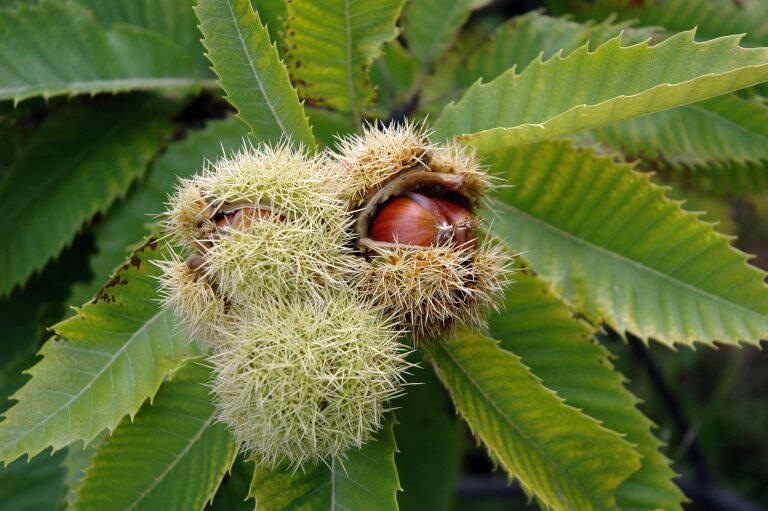Chestnuts date back millennia, and it’s believed they have been cultivated since at least 2,000 B.C. They have served as a staple food for cultures throughout history and around the globe, thanks, in part, to the excellent health benefits they have to offer.
What are Chestnuts?
Chestnuts are the edible fruit of deciduous trees in the family Castanea, which grows in Europe, North America, and Asia. Along with hazelnuts, they are considered fruits and not nuts.
While the North American, Chinese, and Japanese chestnuts are cultivated for food, the most common variety, traditionally eaten from Thanksgiving through the New Year, is the European chestnut, Castanea sativa, also known as Spanish chestnut or sweet chestnut.
Chestnuts grow in clusters of up to seven nuts inside inedible spiny husks. The nut inside is smooth, shiny, and dark brown, and the way the nuts are pressed together within the husk means that each one has a flat side and a rounded side.

Chestnut’s unique qualities
Compared to seeds, nuts, and other fruits, chestnuts are very low in fat and much higher in carbohydrates, giving them a caloric content that’s about 1/4 that of other nuts. They have a carbohydrate content more closely resembling that of wheat and rice than that of other nuts, and when accounting for size, they have twice the amount of starch of potatoes. They’re also a great source of fiber, making them a filling and delicious snack.
In terms of nutrients, chestnuts have some fantastic anti-inflammatory and immune-boosting properties. It turns out that they are one of the most polyphenol-rich foods around, containing more than 1215 mg of polyphenols in just 3.5 ounces of nuts. They’re also a good source of some B vitamins and minerals like copper. Chestnuts also contain a hefty 26 grams of Vitamin C in every 3.5 ounces of nuts, a rare find among nuts.
When shopping for chestnuts, you should look for nuts that are firm, shiny, and without blemishes. Because they are made up of 50-60 percent water, they’re highly perishable. So it’s a good idea to keep chestnuts refrigerated until you’re ready to use them; otherwise, they can lose their water content and dry out.

An enjoyable treat
Food evokes the senses and conjures good memories — and chestnuts are no exception.
I recall the fragrant scent of roasted chestnuts greeting me while strolling near Saikung Seafood restaurant in Hong Kong one winter. An older woman, large spade in hand, was frying chestnuts in a large pot over a roaring fire along the roadside nearby.
To prevent the nuts from scorching, sand was blended in, and the comforting aroma attracted many passersby, including children begging their mothers to buy the delicious snack. I couldn’t help but get a small bag for myself and still recall the delightful taste of those hot chestnuts on a cold winter’s day.
The ‘King of Fruits’
Hu Nai Wen, a Chinese doctor, described chestnuts as the “King of Fruits.” He praised them for their medicinal properties and said that food is a medicine that Heaven has bestowed to humankind. This is 100 percent correct. Of course, we all know that they are delicious, but what are their benefits according to Chinese medicine?
According to Hu Nai Wen, nourishing the kidneys is vital to good health. Similarly, nourishing the blood, regularly moving the bowels, and having a robust immune system are critical to maintaining a healthy body.
Traditional Chinese medicine teaches that having strong kidneys means having good health, as you will be strong enough to resist any severe illness.
The ancient books state that chestnuts can strengthen the kidneys, build strong teeth, and build strong bones in the legs and back, helping relieve pain. They also fortify and boost the blood, decrease the need to urinate at night, and have even been shown to turn gray hair back to black.

Adding chestnuts to your diet
There are some methods for getting chestnuts into your diet.
First, start your day off right with a glass of homemade, sweet chestnut-soybean milk. Combine 16 to 20 ounces of soybean milk with 2/3 ounces of oatmeal in a blender. Add 10 ounces of cooked chestnuts, a little brown or ice sugar, and combine. This recipe is excellent for getting rid of coldness, especially in the stomach and spleen, and increasing energy.
Another idea is to create a chestnut porridge. Combine brown rice, diced chestnut pieces, and red dates in a pot. and cook for one hour. It will be easy to cook soft with a lovely smell and taste delicious. This recipe acts as an immune booster and will help keep your body warm while decreasing coldness in the stomach. It also helps to soothe the spleen, relieve fatigue, and nourish the blood. The fiber in these foods also helps the bowel function smoothly and ease constipation.
A third option is a great winter recipe: chicken soup combined with chestnuts. To begin, heat some oil in a pan. Add garlic and ginger, then fry for two minutes. Add chicken (or lamb if preferred) and fry until it’s golden brown. Next, add some hot water and bring it to a boil. Add mushrooms and chestnuts, along with fresh yams if available.
An ancient Chinese medicine text gives a quick and easy remedy for those suffering from cold hands and feet, fatigue, weakness in their legs, and a deficiency in the blood. You chew two pieces of raw chestnut, both morning and night, until very fine, then swallow. This helps release the nutrients and is an excellent way to strengthen the kidneys.
Adding chestnuts to your cooking is a great way to not only add in some delicious flavor, but to help you keep fit and healthy as well. So why not give these ideas a try? You’ll be glad you did!
Follow us on Twitter, Facebook, or Pinterest

